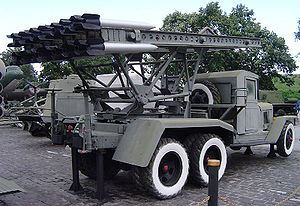Katyusha rocket launcher
| Katyusha | |
|---|---|

BM-13 Katyusha multiple rocket launcher, based on a ZIS-6 truck, Museum of The History of Ukraine in World War II, Kiev (close-up).
|
|
| Type | Multiple rocket launcher |
| Place of origin | Soviet Union |
| Service history | |
| In service | 1939–present |
| Used by | Soviet Union, and others |
| Wars |
World War II Korean War Vietnam War Yom Kippur War Iran–Iraq war 2006 Lebanon War 2011 Libyan civil war Syrian Civil War Northern Iraq Offensive |
| Production history | |
| Designer | Georgy Langemak, Kostikov |
| Manufacturer | Plant Comintern in Voronezh |
| Produced | 30.06.1941 |
| Variants | BM-13, BM-8, BM-31, BM-14, BM-21, BM-24, BM-25, BM-27, BM-30 |
Katyusha multiple rocket launchers (Russian: Катю́ша; IPA: [kɐˈtʲuʂə]) are a type of rocket artillery first built and fielded by the Soviet Union in World War II. Multiple rocket launchers such as these deliver explosives to a target area more quickly than conventional artillery, but with lower accuracy and requiring a longer time to reload. They are fragile compared to artillery guns, but are inexpensive, easy to produce, and usable on any chassis. Katyushas of World War II, the first self-propelled artillery mass-produced by the Soviet Union, were usually mounted on ordinary trucks. This mobility gave the Katyusha (and other self-propelled artillery) another advantage: being able to deliver a large blow all at once, and then move before being located and attacked with counter-battery fire.
Katyusha weapons of World War II included the BM-13 launcher, light BM-8, and heavy BM-31. Today, the nickname is also applied to newer truck-mounted Soviet (and not only Soviet) multiple rocket launchers—notably the common BM-21—and derivatives.
Initially, concerns for secrecy kept their military designation from being known by the soldiers who operated them. They were called by code names such as Kostikov guns (after the head of the RNII, the Reaction-Engine Scientific Research Institute), and finally classed as Guards Mortars. The name BM-13 was only allowed into secret documents in 1942, and remained classified until after the war.
Because they were marked with the letter K (for Voronezh Komintern Factory),Red Army troops adopted a nickname from Mikhail Isakovsky's popular wartime song, "Katyusha", about a girl longing for her absent beloved, who has gone away on military service. Katyusha is the Russian equivalent of Katie, an endearing diminutive form of the name Katherine: Yekaterina →Katya →Katyusha.
...
Wikipedia
